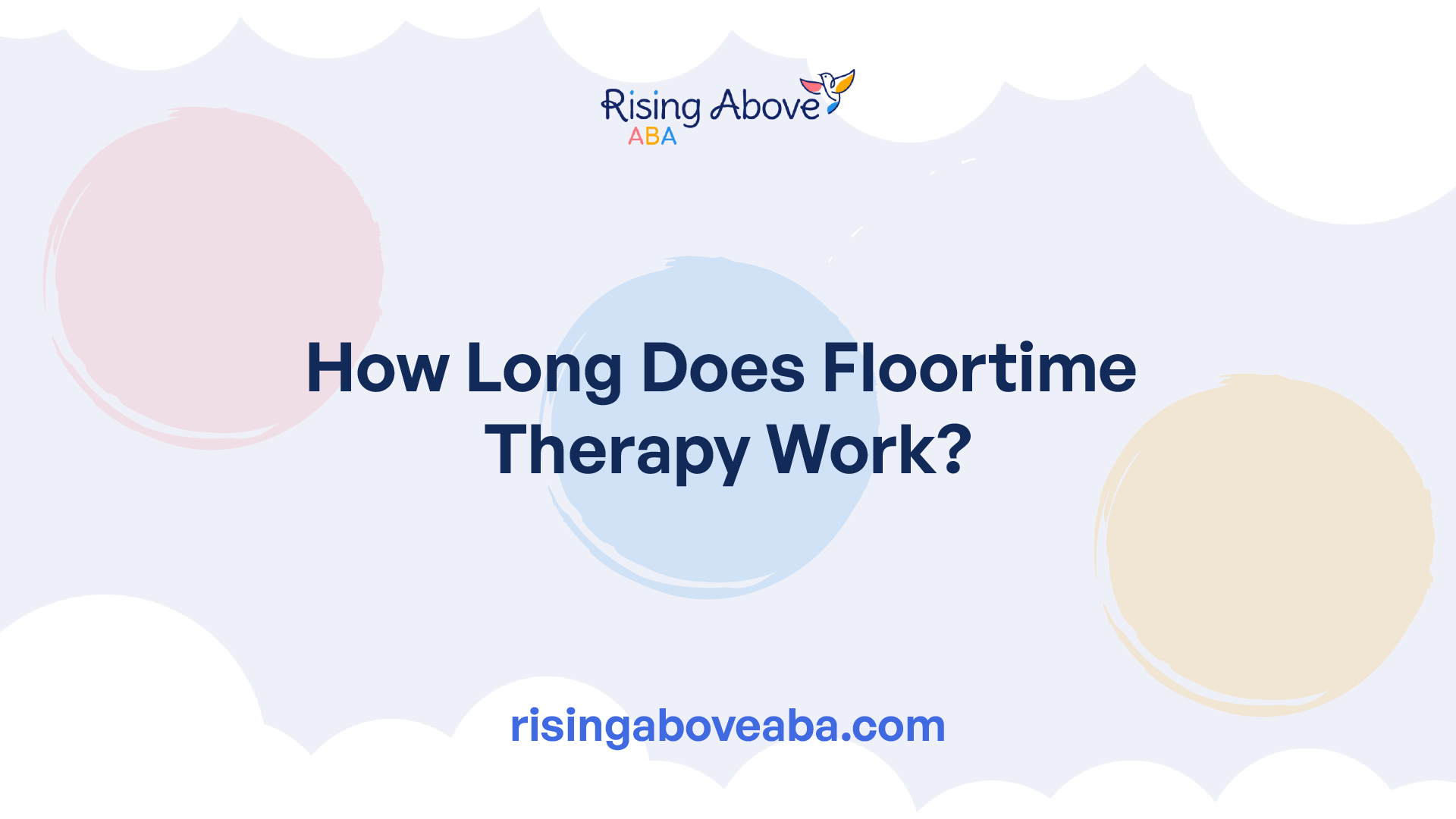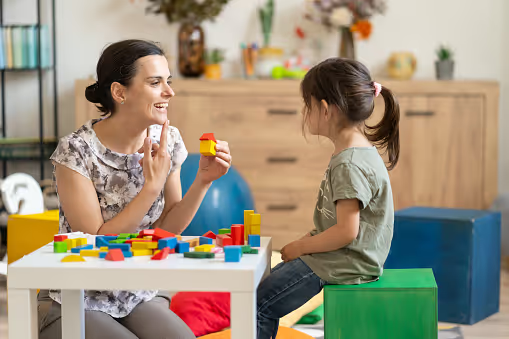How Long Does Floortime Therapy Work?
Unlock the secret of how long Floortime therapy can work wonders for emotional growth and lasting improvements.
.avif)
Understanding Floortime Therapy
Floortime therapy, also known as the Developmental, Individual Differences, Relationship-based (DIR) model, is an intervention approach that focuses on engaging children in child-led, structured play to promote emotional and cognitive development. Understanding the basics of floortime therapy is essential for grasping its significance in the treatment of Autism Spectrum Disorder (ASD).

Basics of Floortime Therapy
Research has shown substantial progress in various functional areas of children with autism undergoing floortime therapy. Home-based floortime interventions have demonstrated improvements in emotive functioning, communication skills, and daily living skills. Furthermore, the interactions between parents and children have shown enhancement, strengthening the parent-child relationship.
The core principle of floortime therapy revolves around child-led play, where the child takes the lead in directing the play, while the therapist or parent follows and supports the child's interests and initiatives. This child-led approach aims to foster emotional connections, enhance communication skills, and promote developmental progression in children with ASD.
Importance of Floortime Intervention
Floortime therapy plays a crucial role in enhancing the relationship between parents and children. By actively engaging in floortime sessions, parents can establish deeper emotional connections with their children, creating a nurturing environment for growth and development. This approach not only benefits the child's progress but also strengthens the parent-child bond, leading to a more supportive and harmonious family dynamic.
While the positive impact of floortime therapy on parent-child relationships is evident, it is essential to acknowledge the need for further research in this field. Studies primarily focus on training parents and therapists to implement floortime interventions, lacking standardized evaluation measures for developmental outcomes. Continued research and evaluation are necessary to enhance the empirical validity of the effectiveness of floortime therapy in treating ASD.
Understanding the fundamental aspects of floortime therapy and recognizing its importance in promoting emotional connections and communication skills are key factors in maximizing the benefits of this child-centered intervention approach. Collaborative support and an individualized approach are essential components in driving the positive outcomes associated with floortime therapy.
Impact of Floortime Therapy
Floortime therapy has been recognized for its positive impact on individuals, particularly children, with autism spectrum disorder (ASD). Two key areas where Floortime therapy showcases significant benefits are in improvements in communication and enhancements in social interaction.
Improvements in Communication
Research studies have demonstrated that Floortime therapy plays a vital role in enhancing communication skills among children with ASD. The results indicate substantial progress in different levels of functioning, including emotive functioning, communication, and daily living skills. Through child-led play and emotional connections established during therapy sessions, children can improve their ability to express themselves, understand others, and engage in social interactions more effectively.
Parental involvement in Floortime therapy is crucial for maximizing the child's improvement in various functioning areas, especially communication. Studies have shown that the more parents engage during Floortime sessions, the better the child's progress. By fostering a supportive and collaborative environment, parents can work alongside therapists to reinforce communication strategies learned during therapy sessions in everyday situations.
Enhancements in Social Interaction
Another significant outcome of Floortime therapy is the enhancement of social interaction skills in children with ASD. Children who participate in DIRFloortime often demonstrate increased relationship-building and social engagement, paving the way for improved social interactions. The individualized approach in Floortime therapy allows therapists to tailor interventions that target specific social challenges faced by each child, promoting developmental progression in social/emotional skills.
Moreover, Floortime therapy enables children to develop adaptive behavior and sensory processing patterns, leading to a more holistic enhancement of their social interactions. By incorporating activities that encourage sensory exploration and emotional connections, children can learn to regulate their responses to social stimuli and engage more meaningfully in social settings. Progressive tracking and evaluation of a child's developmental milestones throughout Floortime therapy sessions help therapists and parents monitor the lasting improvements achieved through the intervention.
By focusing on fostering effective communication and social interaction skills, Floortime therapy provides a nurturing and supportive environment for children with ASD to thrive and reach their full potential. Through continued research and evaluation, the efficacy of Floortime therapy in promoting long-term emotional growth and social development remains a cornerstone in the treatment of individuals with ASD.
Factors Influencing Floortime Effectiveness
When considering the effectiveness of floortime therapy, it's essential to recognize the influence of various factors that can impact its outcomes. Two significant factors that play a crucial role in determining the success of floortime therapy are parental involvement and demographic considerations.
Parental Involvement
Research highlights the critical role of parental involvement in floortime therapy, especially when it comes to enhancing the effectiveness of the intervention. Studies have shown that the level of parental engagement during floortime sessions directly correlates with the child's improvement in various areas, including emotional functioning, communication skills, and daily living abilities. The more active parents are in participating and maintaining consistency in applying the principles of floortime, the greater the positive impact on the child's development and progress [2].
It is essential for parents to understand the principles of floortime therapy and actively engage in child-led play interactions. By fostering a nurturing and supportive environment, parents can help reinforce the emotional connections and promote social interactions that are vital for the child's developmental progress. This collaborative approach between therapists, parents, and the child forms the cornerstone of effective floortime intervention.
Demographic Considerations
Demographic factors of parents can also significantly influence the outcomes of floortime therapy for children with Autism Spectrum Disorder (ASD). Factors such as marital status, income levels, knowledge and attitude towards ASD and floortime, as well as the severity of the child's condition and the duration of treatment, can all impact the effectiveness of the therapy. Understanding these demographic considerations and their potential influence on the therapy process can help tailor the intervention to meet the specific needs of each child and family.
Moreover, studies have shown that certain parental demographics can play a crucial role in determining the success of floortime therapy. By being aware of how these demographic factors interact with the therapy process, therapists and caregivers can provide more personalized and effective support to children with ASD undergoing floortime intervention.
By recognizing the importance of parental involvement and demographic considerations in floortime therapy, practitioners and families can collaborate to create a nurturing environment that maximizes the therapeutic benefits of this child-led intervention. Incorporating these factors into the therapy process can enhance the emotional growth, communication skills, and overall development of children with ASD undergoing floortime intervention.
Benefits of Floortime Approach
When exploring the efficacy of Floortime therapy, it becomes evident that its approach yields significant benefits for children, especially in terms of emotional development and communication skills enhancement.
Emotional Development
Numerous studies, such as Research Source, have demonstrated the positive impact of Floortime therapy on emotional development. Through engaging in child-led play and fostering emotional connections, Floortime intervention helps children with autism enhance their ability to regulate emotions, express feelings, and establish meaningful relationships. By emphasizing individualized interactions and encouraging developmental progression, Floortime therapy paves the way for emotional growth and well-being.
Communication Skills Enhancement
One of the key advantages of Floortime therapy, as highlighted by GoldStar Rehabilitation, is its ability to enhance communication skills in children with autism. By promoting interactive play, imaginative engagement, and social reciprocity, Floortime therapy creates an ideal environment for improving verbal and nonverbal communication. Moreover, by fostering collaborative and supportive interactions between children and their caregivers, Floortime therapy not only enhances language development but also strengthens the parent-child bond.
The individualized approach of Floortime therapy allows for a tailored focus on each child's strengths and interests, leading to positive developmental outcomes in emotional regulation and communication abilities. By incorporating strategies for progress tracking and evaluation in therapy sessions, both emotional growth and communication skills enhancement are continuously fostered, leading to lasting improvements in children who receive Floortime intervention.
Research on Floortime Therapy
Exploring the research on Floortime therapy provides valuable insights into the effectiveness and potential limitations of this therapeutic approach for individuals on the autism spectrum.
Promising Outcomes
Research has indicated substantial progress in different levels of functioning among autistic children undergoing Floortime therapy. According to NCBI, home-based Floortime interventions have shown improvements in emotive functioning, communication skills, and daily living skills. Moreover, significant advancements have been observed in adaptive behavior, sensory processing patterns, and social/emotional skills, including increased relationship-building and enhanced social interaction in autistic children.
One key factor contributing to the positive outcomes of Floortime therapy is parental involvement, as highlighted in the research. The active participation of parents during Floortime sessions enhances the child's progress across various functional areas, emphasizing emotional development, improved communication, and enhanced daily living skills.
Limitations and Future Research
While the existing research on Floortime therapy has demonstrated promising results, it is essential to acknowledge the limitations inherent in these studies. Some research studies may suffer from small sample sizes or lack extended follow-up periods, potentially limiting the generalizability of the findings.
To further evaluate the efficacy of Floortime therapy and address these limitations, it is crucial to conduct more rigorous research studies. This includes implementing randomized controlled trials and larger-scale investigations to corroborate the effectiveness of Floortime therapy in promoting positive outcomes for individuals with autism spectrum disorders.
Continuous research efforts play a pivotal role in refining the Floortime therapy approach and tailoring interventions to better meet the diverse needs of individuals with autism. By expanding the scope of research and incorporating evidence-based practices, the long-term effectiveness and benefits of Floortime therapy can be continuously evaluated and optimized.
Long-Term Effects of Floortime Therapy
Exploring the enduring impact of Floortime therapy reveals profound long-term benefits for individuals, particularly in terms of emotional growth and lasting improvements. This therapeutic approach, rooted in the DIRFloortime model, emphasizes the significance of emotional connections, individualized support, and developmental progression.
Emotional Growth
A core aspect of Floortime therapy is nurturing emotional growth in individuals with developmental challenges. By focusing on fostering emotional connections and promoting empathy, self-regulation, and emotional resilience (MyTeamABA), this therapy encourages individuals to engage in child-led play that enhances their emotional well-being and interpersonal skills. Over time, participants often experience significant emotional growth, marked by increased self-awareness and a deeper understanding of their emotions.
Lasting Improvements
One of the remarkable aspects of Floortime therapy is its ability to elicit lasting improvements in participants. By tailoring interventions to suit individual strengths and interests, Floortime therapy lays a solid foundation for social and emotional development that endures beyond the therapy sessions. This personalized approach not only facilitates skill acquisition but also empowers individuals to cultivate meaningful relationships and navigate social interactions with confidence and competence, enhancing their quality of life in the long run.
As ongoing research on Floortime therapy continues to shape the landscape of intervention strategies for individuals on the autism spectrum (GoldStar Rehabilitation), it is evident that the emotional growth and lasting improvements fostered by this method play a pivotal role in enhancing the well-being and developmental outcomes of participants over time. The enduring effects of Floortime therapy underscore its significance as a valuable and effective intervention for individuals with developmental challenges.
Efficacy of Floortime Therapy
When considering the effectiveness over time of Floortime Therapy, research has shown promising outcomes in the long-term treatment of children with autism spectrum disorder (ASD). The continual evaluation and assessment of the therapy play a vital role in ensuring its ongoing success and benefits.
Effectiveness Over Time
Studies have demonstrated that Floortime intervention yields substantial progress in various levels of functioning among children with autism. Home-based Floortime sessions have been particularly effective in improving emotive functioning, communication skills, and daily living abilities. The nurturing environment created during Floortime sessions fosters emotional connections and enhances social interactions, leading to significant advancements in adaptive behavior and sensory processing patterns.
Parental involvement is a cornerstone of Floortime Therapy's success. Engaging parents in the therapy sessions has been linked to better outcomes for children, particularly in terms of emotional functioning, communication development, and daily life skills. By actively participating in their child's therapy, parents contribute to the child's progress and overall well-being.
Ongoing Evaluation
Continuous progress tracking and evaluation are essential components of Floortime Therapy. By monitoring the child's developmental progression, therapists can tailor the therapy to meet the individualized needs of each child. This collaborative approach ensures that the therapy remains focused on the child's specific goals and areas of growth.
It is important to note that ongoing research in the field of Floortime Therapy is imperative for refining and enhancing the intervention. By conducting further studies, we can deepen our understanding of the therapy's efficacy and its impact on children with ASD. This commitment to research is vital in providing evidence-based support for the continued utilization of Floortime Therapy as a valuable intervention for individuals on the autism spectrum.
Through consistent evaluation and a commitment to research, Floortime Therapy can continue to offer lasting benefits and support the emotional growth, social interaction skills, and overall well-being of individuals with autism spectrum disorder.
Comparing Floortime Therapy
When considering therapeutic interventions for developmental challenges, it's essential to explore the effectiveness of Floortime Therapy in relation to other therapeutic approaches and understand the considerations for its utilization.
Floortime vs Other Therapies
Floortime Therapy, also known as the DIRFloortime® approach, stands out for its emphasis on child-led play and emotional connections [5]. This individualized approach focuses on promoting developmental progression and enhancing social and emotional skills.
In comparison, other therapies, such as Applied Behavior Analysis (ABA) or speech therapy, may have different methodologies and objectives. For instance, ABA typically uses a structured and behavior-focused approach to address specific behaviors, while speech therapy targets communication skills and language development.
When choosing between Floortime Therapy and other therapeutic modalities, it's important to consider the unique needs and preferences of the individual receiving treatment. Collaboration and support from healthcare professionals and therapists play a vital role in determining the most suitable therapy for the individual.
Considerations for Utilization
Before initiating Floortime Therapy or any other therapeutic intervention, several factors need to be taken into consideration to ensure optimal outcomes. These considerations include the developmental stage of the individual, the presence of comorbid conditions, and the availability of resources for long-term support and follow-up [8].
Furthermore, understanding the child's response to the therapy, the level of parental involvement, and the compatibility of the therapy with the individual's sensory needs are crucial aspects to address when utilizing Floortime Therapy. Tracking progress and making necessary adjustments throughout the therapy process are key elements in maximizing the benefits of Floortime Therapy.
By evaluating the effectiveness of Floortime Therapy in comparison to other therapeutic approaches and considering the specific needs of the individual, healthcare professionals and caregivers can make informed decisions regarding the most appropriate intervention for supporting the developmental progress and well-being of the individual.
References
[2]:
[3]:
[4]:
[5]:
[6]:
[7]:
[8]:
[9]:

Compassion. Communication. Positivity. Professionalism
Give us a call at 888.572.7473 or reach out to our team online to get started—we're looking forward to partnering with your family.
Latest articles






Reach Out to Rising Above ABA

Most commercial insurance accepted
Contact us for any questions regarding coverage or plans – we’ll be happy to provide you with the clear guidance as to your best options.


